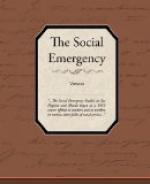One of the chief requisites of the mental training of girls is a knowledge, supplied at the right time and in the right way, of the fundamental principles of reproduction. With such knowledge the girl’s mind will not be distracted by curiosity, or become morbid, when, instead of intelligent response, the girl meets with evasions and attempted concealments. She should not receive this knowledge in the form of isolated facts, but as a correlated part of a great whole to be assimilated gradually. The girl who is trained in this way will understand and accept human reproduction as a natural process.
Questionnaires show that a majority of girls hear the facts of reproduction at the age of seven or eight, a few younger, and a few at the age of ten,—almost none at a later age. The majority hear these facts from children a year or two older, a few from their mothers, and the rest from books. A large number experience a feeling of disgust which remains with them until they receive better information. Their questions disclose a depth of ignorance and misconception which is appalling.
Girls, at the age of twelve, thirteen, or fourteen, should have presented to them a course in physiology which includes the anatomy and hygiene of the reproductive organs. This is carefully omitted from present-day secondary-school textbooks. This course should use charts, pictures, and models. The significance of menstruation, the hygiene of the period, and the causes and prevention of pain should be explained. Under the hygiene of the period, the daily bath should be urged, with caution against chills, in which lies the only possibility of injury. The fertilization of the ovum and cell division may be described by use of the blackboard and embryological models of the later stages of development. The forces which bring about labor can be explained without unduly stressing the attending pain.
The course would be incomplete without a discussion of the necessity of careful selection in marriage from the eugenic standpoint. The perils and results of the venereal diseases should be told simply and frankly. The instruction in eugenics, like that in reproduction, should be progressive and indirect, at least up to the age of seventeen or eighteen years. Again it may be correlated with plant life by pointing out the beauty of strong, hardy plants and their relation to the seeds. Children can be taught to save the seeds of the most beautiful blossoms for the following year. Instruction can be continued with the lower animals. The child will then grow up with the idea that strength and vigor and freedom from disease are desirable qualities, and must exist in the parent if they are to exist in the offspring. The idea can be readily carried over to the human family. At the age of seventeen or eighteen, the influence of heredity and the effects of the racial poisons should be fully explained, and emphasis laid upon qualities necessary for racial betterment.




